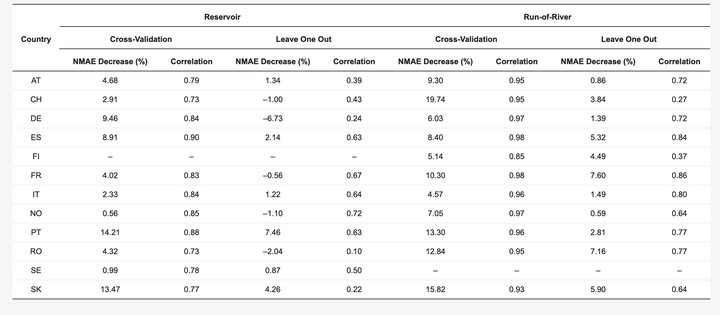Reconstruction of Multidecadal Country-Aggregated Hydro Power Generation in Europe Based on a Random Forest Model
 Results of the 5-fold cross-validation multiple lags model with temperature and precipitation: Pearson’s correlation coefficient with respect to ENTSO-E data, and NMAE decrease (in %) compared to the performance of the optimal lag model.
Results of the 5-fold cross-validation multiple lags model with temperature and precipitation: Pearson’s correlation coefficient with respect to ENTSO-E data, and NMAE decrease (in %) compared to the performance of the optimal lag model.
Abstract
Hydro power can provide a source of dispatchable low-carbon electricity and a storage solution in a climate-dependent energy mix with high shares of wind and solar production. Therefore, understanding the effect climate has on hydro power generation is critical to ensure a stable energy supply, particularly at a continental scale. Here, we introduce a framework using climate data to model hydro power generation at the country level based on a machine learning method, the random forest model, to produce a publicly accessible hydro power dataset from 1979 to present for twelve European countries. In addition to producing a consistent European hydro power generation dataset covering the past 40 years, the specific novelty of this approach is to focus on the lagged effect of climate variability on hydro power. Specifically, multiple lagged values of temperature and precipitation are used. Overall, the model shows promising results, with the correlation values ranging between 0.85 and 0.98 for run-of-river and between 0.73 and 0.90 for reservoir-based generation. Compared to the more standard optimal lag approach the normalised mean absolute error reduces by an average of 10.23% and 5.99%, respectively. The model was also implemented over six Italian bidding zones to also test its skill at the sub-country scale. The model performance is only slightly degraded at the bidding zone level, but this also depends on the actual installed capacity, with higher capacities displaying higher performance. The framework and results presented could provide a useful reference for applications such as pan-European (continental) hydro power planning and for system adequacy and extreme events assessments